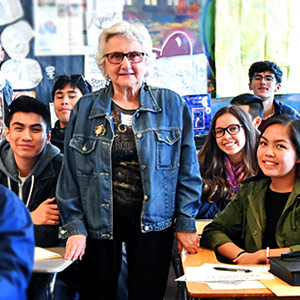by Dr. Andrea Struve
With Thanksgiving fast approaching, many of us will be giving thanks for our families, friends, and communities. However, it’s crucial to acknowledge the complex history of Thanksgiving, rooted in both the pursuit of religious freedom through colonial settlement and harmful actions toward Native peoples. Reflecting on this history enables us to recognize the past and extend allyship to Native communities today.
This inclusive practice of remembrance is an essential piece of the JFCS Holocaust Center’s work through the California Teachers Collaborative for Holocaust and Genocide Education.
We invite you this holiday season to unpack the history of Thanksgiving further to understand indigenous history and become a stronger native ally.
The History
When the Mayflower landed in Jamestown in 1620, the ship was filled with Puritans (also known as Pilgrims) seeking religious freedom from the oppressive Anglican Church in Britain. However, the Puritans did not extend the same freedoms to the people already inhabiting the land.
Where these Puritans settled—Plymouth Rock in Massachusetts—there was already a village located there. It was called Patuxet and the Wampanoag Indians lived there with the Pequot tribe, a close neighbor in Connecticut.
The Wampanoag Indians welcomed the Puritans and provided all food for a feast alongside the teachings of agriculture (i.e. corn, beans, wild rice) and hunting (i.e. turkey) on this “new” soil. The Puritans perceived Native Americans as “relatives of the Devil” due to their skin color, language, and religion, and used this feast the Natives provided to negotiate a treaty that would secure the lands for themselves.
By 1637, the Puritans had expanded southwest into Connecticut and Pequot’s ancestral land. The Pequot refused to sign a treaty like their neighbors the Wampanoag, which caused tension and violence, resulting in 13 English traders being murdered outside of the Puritan village.
On orders by the governor, John Mason and John Underhill led a group of colonist mercenaries to punish the Pequot and seek revenge. As the Pequot gathered for the annual Green Corn Dance ceremony to celebrate their autumnal harvest and give thanks for what earth provided for them – an abundant crop – the English attacked and surrounded the Pequot village, burning down everything and shooting whoever tried to escape.
After three days of similar violence against the Pequot, the Governor of Massachusetts Bay Colony, declared: “A day of Thanksgiving, thanking God that they had eliminated over 700 men, women, and children.” He then enslaved all Pequot who remained to begin expanding the colonial settlements further and faster.
Although the origination of the holiday is debated between the history above and belief of its formalization during the Civil War (1863) when President Lincoln proclaimed a Thanksgiving holiday, most historians firmly agree that Thanksgiving came into existence in between these two events, effectively marking the beginning of colonial settlement and policies of genocide against native peoples in the United States.
Call to Action
We invite you to continue learning more about Thanksgiving and indigenous history to expand your allyship toward native peoples through the work of our CA Teachers Collaborative for Holocaust and Genocide Education partners:
- Attend Masterclass: Going Beyond Land Acknowledgements on Jan. 9th from our partners at Redbud Resource Group to learn about the strengths and limitations of land acknowledgments and explore concrete, action-oriented strategies for building connections with Native communities and organizations.
- Read Disrupting Public Memory: The Story of the National Day of Mourning from our partners at Facing History and Ourselves to learn more about how historians and Indigenous communities have broken down the historically one-sided narrative about Thanksgiving in the US has been a decades-long effort, led by historians and Indigenous communities.

